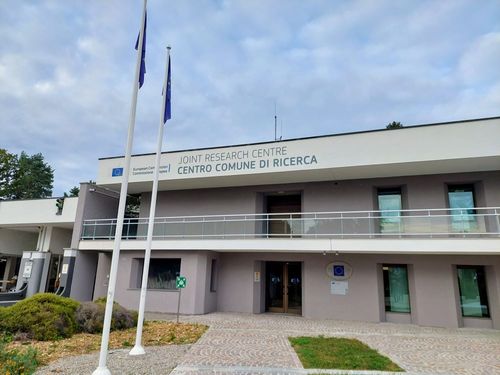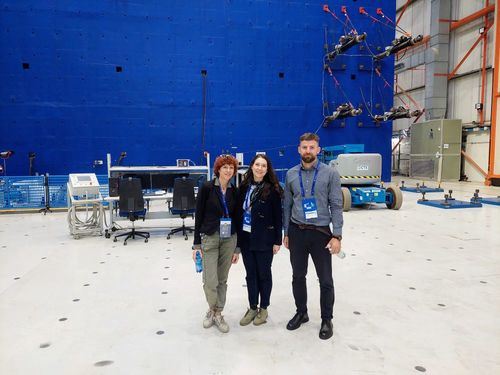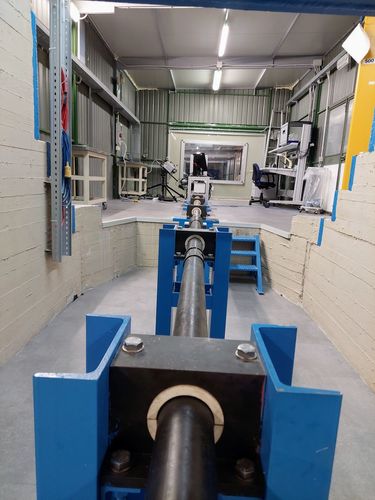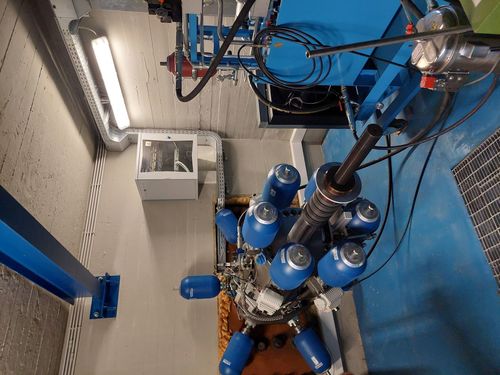Home
For international students
Benefits of the Joint Research Centre program: VILNIUS TECH researchers expand research horizons
- Programmes in English 2026/2027
- Admission 2026/2027 Scholarships
- For exchange students
- Free Movers
- Transfer studies
- Erasmus+ studies and traineeships
- Mentor programme
- Student testimonials
- Accommodation
- Career Services
- Medical Care
- Immigration Regulations
- Leisure and Student Activities
- Useful information
- Mental and spiritual support
- Representatives Abroad
- Contacts
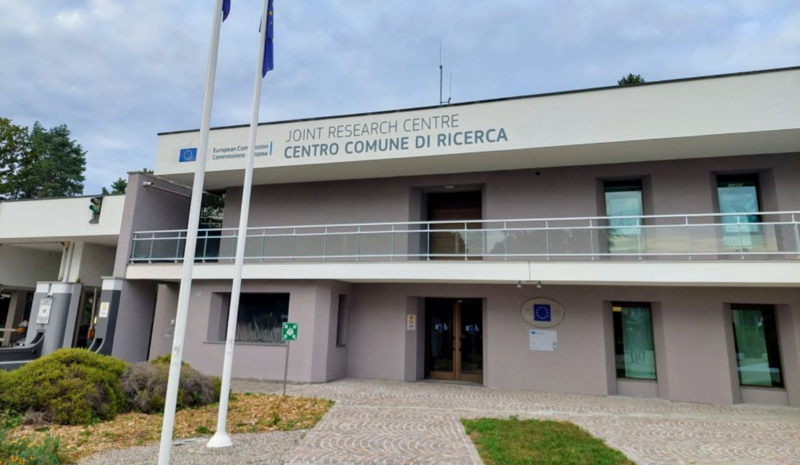
2024-10-15
Benefits of the Joint Research Centre program: VILNIUS TECH researchers expand research horizons
The Joint Research Centre (JRC) is implementing a Training and capacity building program, which opens its laboratories to the academic community, research organizations, small and medium-sized enterprises, as well as representatives from the public and private sectors.
Scientists and researchers from these organizations come to gain, improve, and develop their knowledge, competencies, and skills in order to successfully conduct research in life and physical science fields. Last spring, researchers from the Innovative Building Structures Laboratory at Vilnius Gediminas Technical University (VILNIUS TECH) took advantage of this program and through their formed consortium travelled to a laboratory located in Isproje, Italy, to expand their research activities.
Initiation of a new research direction
According to VILNIUS TECH researcher Associate Professor Dr. Arvydas Rimkus, the protection of civil structures is indeed very important for society. "Apart from extreme disasters, which have devastating consequences for both infrastructure and its users, new challenges and dangers have arisen due to military actions. Advanced civil safety requires easy to construct, compact, and durable systems with high impact and/or explosion energy absorption capacities. Therefore, our initiative has led to research activities focused on developing a lightweight layered composite system with mechanical properties tailored for the protection of civil infrastructure," explains Dr. Rimkus.
It is noteworthy that the laboratory in Isproje is equipped with the world’s largest Hopkinson bar facility used to characterize dynamic properties of materials, measuring over 200 meters in length, capable of generating forces of 1 MN, with impulse durations of 40 ms and speeds of 15 m/s. Tests conducted with this equipment are particularly relevant and significant for the impact-resistant layered composite system that is being developed by VILNIUS TECH researchers.
"This JRC program also highly promotes international collaboration, which is awarded additional points in project applications. Our team (Associate Professor Dr. Arvydas Rimkus, Associate Professor Dr. Ieva Misiunaite, Professor Dr. Viktor Gribniak) has been joined by Dr. Violetta Kyinou from Thracian University. JRC experts favourably evaluated the project application prepared by our consortium and awarded an opportunity to conduct the planned research," shares the scientist, adding that the researchers at JRC have been supportive by taking into consideration the proposal to adapt the training program to the activities of the VILNIUS TECH laboratory.
Scientific-practical value of the conducted research
The research conducted by VILNIUS TECH scientists established the compatibility of physical and mechanical properties of cement composite reinforced with stainless steel fibers, which demonstrated the material's effectiveness under impact (ballistic) conditions. By combining the developed cement composite with added manufactured polymer structures, research has been initiated to create a layered composite with expanded functionality, tailored for impact and explosion-resistant modular systems. These systems will be intended for civil safety and the protection of defense infrastructure, shelters, or temporary command posts.
To further develop the created system, both component and layered system research under dynamic (impact) loads is necessary. Standard laboratory equipment, which determines the material's response to dynamic impacts lasting tenths of a second, is designed for small, uniform material samples up to a few millimeters in diameter. Research on layered composite systems requires specialized equipment that is compatible with relatively large-sized samples and capable of generating very high-power impulses. This need for laboratory equipment was crucial for continuing the initiated research.
... and personal benefits
When asked about professional and personal achievements that bring the most joy, Dr. A. Rimkus highlights the received appreciation for the efforts and results achieved. "We, as scientists, spend many hours in laboratories, often without noticing progress. This trip gave us the opportunity to realize the relevance of our ongoing research and the significance of the results achieved. The chance to use unique equipment globally alongside researchers from the leading scientific centres in Europe is rare. The positive evaluation of the research conducted by VILNIUS TECH by JRC indicates that we are moving in the right direction. For me, as a scientist who loves my work, such recognition has become an additional motivation to pursue new goals," reflects the researcher.
Future perspectives and plans
VILNIUS TECH researchers, together with 20 other researchers from various European research centres, participated in a four-day visit. During this time, experimental tests were conducted to determine the dynamic properties of steel, cement, and polymer composite materials. Additionally, the contacts made with other participants during the trip enabled the development of collaborative research between VILNIUS TECH scientists and other researchers. Based on this research, a joint application for the LMT group project call was submitted with researchers from Ghent University (Belgium).
It is essential to mention that the research initiated during the trip will continue in collaboration with JRC scientists, with further experimental studies planned to be carried out in the same JRC laboratory. JRC provides the opportunity to use laboratories by submitting project applications, with the next call planned for early 2025.
For consultations on submitting applications under the Horizon Europe research and innovation program's regulations and participation in it, please feel free to contact the National Contact Point group of the Lithuanian Research Council.
Photos from a personal album.
Original source: https://europoshorizontas.lt/jungtiniu-tyrimu-centro-programos-nauda-vilnius-tech-mokslininkai-praplete-tyrimu-ribas/
Scientists and researchers from these organizations come to gain, improve, and develop their knowledge, competencies, and skills in order to successfully conduct research in life and physical science fields. Last spring, researchers from the Innovative Building Structures Laboratory at Vilnius Gediminas Technical University (VILNIUS TECH) took advantage of this program and through their formed consortium travelled to a laboratory located in Isproje, Italy, to expand their research activities.
Initiation of a new research direction
According to VILNIUS TECH researcher Associate Professor Dr. Arvydas Rimkus, the protection of civil structures is indeed very important for society. "Apart from extreme disasters, which have devastating consequences for both infrastructure and its users, new challenges and dangers have arisen due to military actions. Advanced civil safety requires easy to construct, compact, and durable systems with high impact and/or explosion energy absorption capacities. Therefore, our initiative has led to research activities focused on developing a lightweight layered composite system with mechanical properties tailored for the protection of civil infrastructure," explains Dr. Rimkus.
It is noteworthy that the laboratory in Isproje is equipped with the world’s largest Hopkinson bar facility used to characterize dynamic properties of materials, measuring over 200 meters in length, capable of generating forces of 1 MN, with impulse durations of 40 ms and speeds of 15 m/s. Tests conducted with this equipment are particularly relevant and significant for the impact-resistant layered composite system that is being developed by VILNIUS TECH researchers.
"This JRC program also highly promotes international collaboration, which is awarded additional points in project applications. Our team (Associate Professor Dr. Arvydas Rimkus, Associate Professor Dr. Ieva Misiunaite, Professor Dr. Viktor Gribniak) has been joined by Dr. Violetta Kyinou from Thracian University. JRC experts favourably evaluated the project application prepared by our consortium and awarded an opportunity to conduct the planned research," shares the scientist, adding that the researchers at JRC have been supportive by taking into consideration the proposal to adapt the training program to the activities of the VILNIUS TECH laboratory.
Scientific-practical value of the conducted research
The research conducted by VILNIUS TECH scientists established the compatibility of physical and mechanical properties of cement composite reinforced with stainless steel fibers, which demonstrated the material's effectiveness under impact (ballistic) conditions. By combining the developed cement composite with added manufactured polymer structures, research has been initiated to create a layered composite with expanded functionality, tailored for impact and explosion-resistant modular systems. These systems will be intended for civil safety and the protection of defense infrastructure, shelters, or temporary command posts.
To further develop the created system, both component and layered system research under dynamic (impact) loads is necessary. Standard laboratory equipment, which determines the material's response to dynamic impacts lasting tenths of a second, is designed for small, uniform material samples up to a few millimeters in diameter. Research on layered composite systems requires specialized equipment that is compatible with relatively large-sized samples and capable of generating very high-power impulses. This need for laboratory equipment was crucial for continuing the initiated research.
... and personal benefits
When asked about professional and personal achievements that bring the most joy, Dr. A. Rimkus highlights the received appreciation for the efforts and results achieved. "We, as scientists, spend many hours in laboratories, often without noticing progress. This trip gave us the opportunity to realize the relevance of our ongoing research and the significance of the results achieved. The chance to use unique equipment globally alongside researchers from the leading scientific centres in Europe is rare. The positive evaluation of the research conducted by VILNIUS TECH by JRC indicates that we are moving in the right direction. For me, as a scientist who loves my work, such recognition has become an additional motivation to pursue new goals," reflects the researcher.
Future perspectives and plans
VILNIUS TECH researchers, together with 20 other researchers from various European research centres, participated in a four-day visit. During this time, experimental tests were conducted to determine the dynamic properties of steel, cement, and polymer composite materials. Additionally, the contacts made with other participants during the trip enabled the development of collaborative research between VILNIUS TECH scientists and other researchers. Based on this research, a joint application for the LMT group project call was submitted with researchers from Ghent University (Belgium).
It is essential to mention that the research initiated during the trip will continue in collaboration with JRC scientists, with further experimental studies planned to be carried out in the same JRC laboratory. JRC provides the opportunity to use laboratories by submitting project applications, with the next call planned for early 2025.
For consultations on submitting applications under the Horizon Europe research and innovation program's regulations and participation in it, please feel free to contact the National Contact Point group of the Lithuanian Research Council.
Photos from a personal album.
Original source: https://europoshorizontas.lt/jungtiniu-tyrimu-centro-programos-nauda-vilnius-tech-mokslininkai-praplete-tyrimu-ribas/












